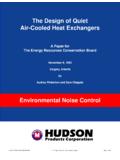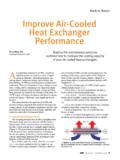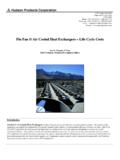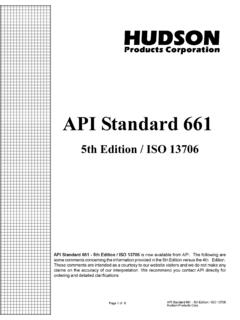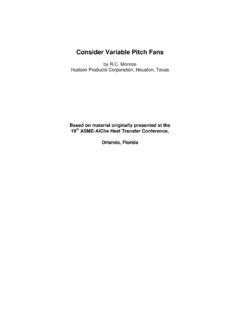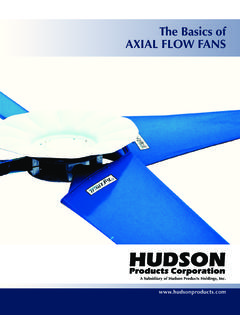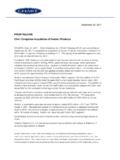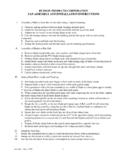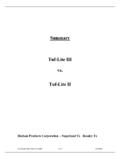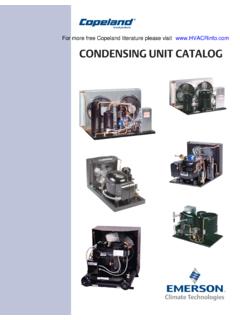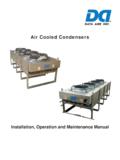Transcription of Noise Control of Air-Cooled Heat Exchangers
1 Noise Control of Air-Cooled heat Exchangersby ShipesHudson Products Corporation, Houston, TexasPaper for a Presentation at a Session on Noise Results of Various Approaches to ControlPresented at the37thMidyear Meeting of the American PetroleumInstitute's Division of Refiningin the Waldorf-AstoriaNew York, New YorkMay 10, 1972 Hudson Products CorporationPage 2 of 11 Houston, TexasNoise Control of Air-Cooled heat ExchangersNOISE Control OF Air-Cooled heat EXCHANGERSby K. V. ShipesHudson Products Corporation, Houston, TexasPaper for a Presentation at a Session on Noise Results of Various Approaches to Control During the 37thMidyear Meeting of the American Petroleum Institute's Division of Refining, in the Waldorf-Astoria,New York, New York, May 10, paper deals with Noise caused by Air-Cooled heat Exchangers .
2 Points discussed are thesource and mechanism involved, as well as the relationship of the variables affecting such directionality, specification objectives, available range of Noise and costs of quietingare heat Exchangers (FIN-FAN units) are being used more extensively year by year inrefineries, petrochemical plants and many other places where heat must be removed from a the same time, several factors are coinciding to focus attention on Noise generated by theseexchangers. Normally speaking, FIN-FAN units are less noisy than several other commonlyoccurring Noise sources in plants (vents, furnaces, gear pumps, etc.)
3 However, due to thedependency of air coolers on unrestricted air flow, it is more expensive to achieve a given noisereduction on FIN-FAN unit than on most other types of equipment. In many cases, one cansimply contain the Noise . In the case of furnaces, the limited air flow can be conveyed through aduct, which gives the required literature reflects the variety of opinions presently held as to the cause of FIN-FAN unit snoise. Several factors that have been considered are:1)Rotating forces (blade pass frequency plus harmonics)2)Random vortex shedding3)Air turbulence4)Air flow over fins5)Bearing rumble6)Resonant effect of air-cooler plenum chamberHudson Products CorporationPage 3 of 11 Houston, TexasNoise Control of Air-Cooled heat ExchangersThere have also been several equations developed which attempt to predict the Noise resultingfrom FIN-FAN units with large axial flow (1) gives:PWL (overall) = 138 + 20 log hp - 10 log q(1)Where.
4 PWL = sound power level (re 10-12watts), dBhp = motor shaft horsepowerq = acfm, fan discharge(Intended for both axial flow and centrifugal fans)Allen (2) gives:PWL (overall) = 68 + 10 log q + 20 log p(2)Where:p = static pressure, inches H20 Gordon, et al (3) gives:PWL (125 Hertz) = 60 log (Vt x 10-3)+10 log acfm -7(3)Where:Vt = tip speed, ft/minUnderwood (4) gives:PWL (125 Hertz) = 55 log10(Vt x 10-3)+ 20 log hp (abs)(4)-10 log acfm + 10 log (N) - 96 Where:N = number of bladesHudson Products CorporationPage 4 of 11 Houston, TexasNoise Control of Air-Cooled heat ExchangersSeebold (5) gives:An equation to predict the SPL at a specific point with respect to the unit.
5 For induced-draftunits, at three feet below the tubes:(5)Where:SPL = sound pressure level (re microbars), dBhp = hp, consumed power basisD = fan diameter, forced-draft units, Seebold adds about 5 (6) gives:PWL (overall) = 56 log Vt + 10 log [ ]+A2(6)Where:Cm = blade mean chord width, = blade length, hub to tip, = number of bladesA2= constantAnother correlation by Lawrence (7) gives:PWL (overall) = 95 + 10 log hp(7)Considering these equations in order, equation (1) states that the Noise energy is proportional tothe horsepower raised to a power of and to acfm to a power of and is unaffected by tipspeed, P, fan size, number of blades, (2) states that the Noise energy is proportional to acfm to a power of and Ptoapower of and ignores all other (3) states that the Noise energy is proportional to tip speed to a power of and acfm toa power of and ignores all other (4)
6 States that the Noise energy is proportional to tip speed to a power of , hp to apower of , acfm to a power of , number of blades to a power of and ignores (5) states that the Noise energy is proportional to hp to a power of , tip speed to apower of , fan diameter to a power of , and number of blades to a power of +=747412610000 Vthp2063//DNlog)overall(SPLH udson Products CorporationPage 5 of 11 Houston, TexasNoise Control of Air-Cooled heat ExchangersEquation (6) states that the Noise energy is proportional to tip speed to a power of , meanblade chord width to a power of , and blade length and number of blades to a power of to this diversity of opinion, data taken by one group may be evaluated withconsiderably different results by another group.
7 This problem arises because an air cooler is adirectional Noise source, and does not lend itself readily to techniques, the aim of which is toassign a PWL value to one or two points within its method behind most of these correlations is simply to develop an equation which isreasonable and most closely matches test results. The work of Sharland reflects a wider range ofvariables due to being based on a small scale setup in which the variables could be changed, oneat a is suggested that the method of correlating data on existing units is self-limiting, in a is, no points are represented beyond present practice, whether tip speed, horsepower, acfm,etc.
8 No data has been made available in the literature in which one or more representative unitswere tested, changing one variable at a after such a program is carried out will there be reasonable agreement on the relativeinfluence of the several variables involved. In this respect, the work of Sharland is important(even though his experiments were on a rotor of 6" diameter) because this rule was are several observations reflecting the writer's opinions as to the source of FIN-FAN unit s Noise and the relationship of the several )FIN-FAN unit s Noise is fan-generated Noise . Less than one percent of the noiseenergy can be related to panel or structural vibration.
9 However, structuralcomponents may influence fan-generated Noise by creating additional turbulencearound the )This fan-generated Noise is caused by vortex shedding and air turbulence. It isbroad band without discrete peaks (other than the blade pass frequency, which isnormally below 31 hertz).3)The evidence is that this Noise is proportional to tip speed to a power of to )The parameter of next importance is neither horsepower nor acfm, but is pressuredifferential across the fan. The exponent on P is about but varies inverselywith tip )Acfm is of very little importance, as is horsepower. The acfm can be varied over a10/1 range with very little effect on Noise , assuming other variables are heldconstant, and the stall range is not Products CorporationPage 6 of 11 Houston, TexasNoise Control of Air-Cooled heat Exchangers6)Regarding fan size, inadequate data exists to do more than make a guess at )Regarding number of blades, the evidence is this is not significant if one avoidsthe stall range.
10 This point will be expanded later in the the previous seven statements pertaining to FIN-FAN unit s Noise , some discussionis in order. The fourth statement is that fan Noise is proportional to the pressure differentialacross the fan to an exponent of , and that this exponent varies inversely with tip speed. Thismay readily be demonstrated by operating a given fan at four states as follows:a) Vtl, P1b) Vtl, P2c) Vt2, P1d) Vt2, P2 The pertinent Noise data of these four tests will show a greater variation of Noise caused by thechange in P at the lower tip speed than at the higher tip fifth statement is that both acfm and horsepower are of little importance.
